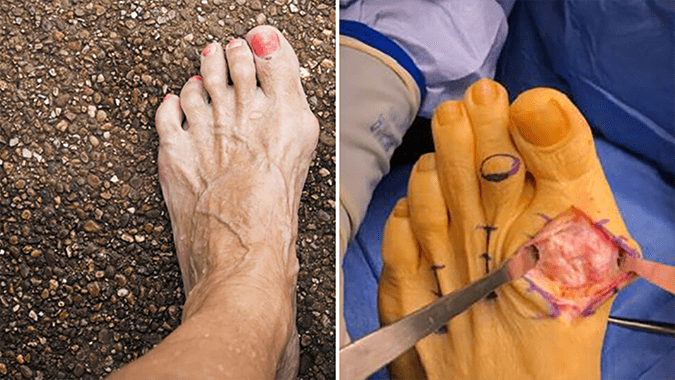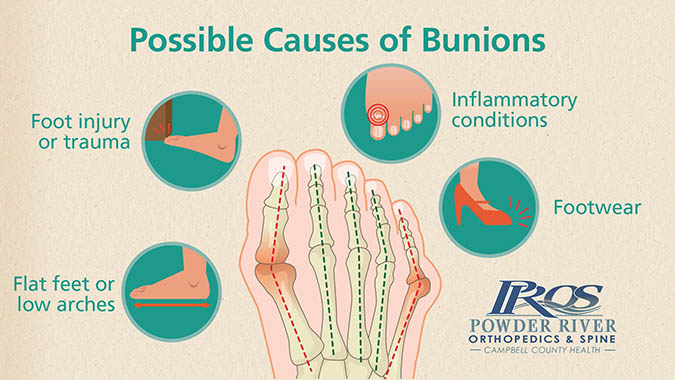In
sandal or boot season, you may be thinking that it’s about time to do something
about that large bump sticking out near your big toe.
That painful, bony bump is what doctors call a hallux valgus, or what is
more commonly known as a bunion.
Hallux valgus vs. hallux rigidus
Some of the complex medical terms in orthopedics can be confusing for patients.
Below is an outline, with photos, of what a hallux valgus (bunion) and
a hallux rigidus are.
 Figure 1 (left): Hallux valgus, the “bump” is on the inside of the big toe.
Patient with a hallux valgus deformity, this is a classic photo of a bunion,
notice that the bump is on the inside of the big toe.
Figure 1 (left): Hallux valgus, the “bump” is on the inside of the big toe.
Patient with a hallux valgus deformity, this is a classic photo of a bunion,
notice that the bump is on the inside of the big toe.
Figure 2 (right): Hallux rigidus, the “bump” is on the top of the big toe joint,
metatarsophalangeal joint (the MTP joint). This is an arthritic condition,
where cartilage in the joint is lost, and abnormal motion creates bone
spurs, or osteophytes. Intraoperative photograph of a procedure in a patient
with severe hallux rigidus, joint destruction and bone spurs.
Mechanics of bunions (hallux valgus)
Bunions are formed when the big toe is forced to bend toward the others
instead of pointing straight ahead—the bone or tissues at the
joint at the bottom of the big toe move out of place.
Over time, this abnormal motion and pressure on the joint can throw the
bones out of alignment and produce a painful lump of bone known as a bunion.
If bunions are not corrected, they can cause skin irritation in adjacent
toes, skin breakdown and painful arthritis, which can make walking painful.

Possible causes of bunions
- Bunions can often run in families—people who have low arches of flat
feet are more susceptible.
- They can also develop from a foot injury or having an inflammatory condition
such as rheumatoid arthritis.
- Shoe wear: High heels or shoes that are pointed and too tight may also
be to blame.
- Other causes can include genetic disorders or neuromuscular conditions.
Symptoms of a bunion can include
- pain and tenderness
- redness and inflammation
- hardened skin on the bottom of the foot
- a callus or corn on the bump
- stiffness and restricted motion in the big toe, which may lead to difficulty
in walking or wearing shoes
If your foot pain starts to interfere with daily activities, it’s
important to schedule an appointment with an orthopedic foot specialist
to determine if it’s a bunion, or another condition. If a bunion
is discovered, your doctor will discuss your options.
Non-surgical treatment options
-
Change shoes—well-fitting shoes with wide toe boxes to give feet more space.
-
Padding, taping or splinting—purchase over-the-counter bunion pads, or ask your doctor to help
you tape your foot in a normal position.
-
Medications—take acetaminophen (Tylenol), ibuprofen (Advil) or naproxen sodium
(Aleve) can help with the pain.
-
Ice/massage—icing your feet can help relieve soreness and inflammation, as can
massaging the feet or using a warm soak/whirlpool.
-
Shoe inserts—over-the-counter arch supports or prescription orthotic devices
can provide relief for some.
When conservative approaches don’t work, or you’ve felt pain
for more than a year, surgery is another option. Bunions can result in
other painful foot problems including hammertoes, bursitis, a bunion below
the little toe (a bunionette), or pain in the balls of your feet.
The goal of bunion surgery is to return the big toe to its correct position. There are several surgical procedures to correct bunions and can include
realigning bone, ligaments, tendons, and nerves so that the big toe can
be brought back to its correct position.
Many bunion
surgeries are done on a same-day basis with no stay at
Campbell County Memorial Hospital.
Expert Orthopedic & Spine Care in Gillette, Wyoming
Dr. Robert Grunfeld is a board-certified orthopedic surgeon who specializes in foot and ankle
surgery at
Powder River Orthopedics & Spine (PROS) in Gillette, Wyoming. He has completed a fellowship in Foot and
Ankle surgery at the University of Rochester, New York, with some of the
international leaders in Orthopedic Foot and Ankle surgery.
The physicians at PROS take an innovative and comprehensive approach to
the treatment of acute and chronic orthopedic pain. Have your procedure
in our modern operating rooms at Campbell County Memorial Hospital or
Powder River Surgery Center.
See the PROS for:
- General orthopedic surgery
- Joint replacement surgery: shoulder, hip, knee and ankle
- Shoulder, elbow, hand and wrist surgery
- Sports Medicine
- Spine surgery and injections, including minimally invasive procedures
- Bunions and great toe arthritis procedures
- Foot and ankle surgery
- Trauma and fracture care
- Workplace injuries
For a consultation, call 307.686.1413 or visit
www.cchwyo.org/PROS.
PROS is a Campbell County Medical Group Clinic with Campbell County Health.